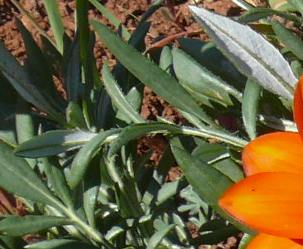Gazania rigida
Gazania rigida (Burm.f.) Roessler
Family: Asteraceae
Common names: Karoo gazania
Introduction
Gazania rigida is not easy to miss during late winter to early summer when it colours the landscape in bright splashes of orange and yellow.

Description
Description
This stemless perennial grows to 20-25 cm high. The leaves are pinnatisect (divided down to the midrib) with lobes which vary from elliptic to often being linear-oblanceolate (very narrow to inversely lance-shaped). The underside of the leaves is white-felted. Leaf margins are revolute (rolled back).
The yellow or orange flowerheads are 35-45 mm across and the rays usually have a dark area at the base, forming a dark ring inside the flowerhead. The involucre (the bracts surrounding the flowerhead) is coarsely hairy and the inner bracts are acute. Flowering is from July to November.

Conservation Status
Status
Gazania rigida has a status of Least Concern (LC) (Raimondo et al. ( 2009).
Distribution and habitat
Distribution description
Gazana rigida is widespread on flats and lower slopes from Namaqualand, the Western Karoo to the Caledon area, and also from Riversdale to Humansdorp.
Derivation of name and historical aspects
History
The genus Gazania is named after Theodore of Gaza (1398-1478) who translated Theophrastus' botanical works from Greek into Latin. The specific epithet rigida means rigid and probably refers to the stiff leaves. The genus Gazania consists of about 17 species occurring mainly in Namibia and South Africa.
Ecology
Ecology
The bright yellow or orange flower heads of Gazania rigida are visited by many insects which aid with pollination.

Uses
Use
No cultural uses are recorded, but this species is a very interesting garden subject.
Growing Gazania rigida
Grow
Sow the seed during autumn in a well-draining medium. Level the medium and then sow the light seeds evenly, water gently, and cover with a thin layer of sand or bark. The seeds will germinate within two to three weeks.
The seedlings are ready to be potted as soon as they are large enough to handle. These potted seedlings will initially need a sheltered position, such as under a shade net, and can gradually be introduced to full sun.
Gazania rigida needs full sun and ample drainage. Plant it as a border plant, and use it en masse as a groundcover planting, in rockeries, or as a pot subject.
In its natural environment the Karoo gazania is found to grow with a variety of species such as Berkheya glabrata, Sparaxis pillansii, Heliophila spp., Lampranthus haworthii, Drosanthemum latipetaluma, Dimorphotheca sinuata, Cotula barbata, and Senecio cakeiliefolius.
References
- Goldblatt, P. & Manning, J. 2000. Cape Plants. A conspectus of the Cape flora of South Africa. Strelitzia 9. National Botanical Institute, Pretoria & Missouri Botanical Garden, Missouri.
- Manning, J. & Goldblatt, P. 1997. Nieuwoudtville . South African Wild Flower Guide 9. Botanical Society of South Africa, Cape Town.
- Raimondo, D.,Von Staden, L., Foden, W., Victor, J.E., Helme, N.A., Turner, R.C., Kamundi, D.A. & Manyama, P.A. (eds). Red List of South African plants 2009. Strelitzia 25. South African National Biodiversity Institute, Pretoria.
- Stearn, W. 2002. Stearn's dictionary of plant names for gardeners. Timber Press, Portland, Oregon.
Credits
Roger Oliver
Kirstenbosch National Botanical Garden
September 2013
Plant Attributes:
Plant Type: Perennial
SA Distribution: Northern Cape, Western Cape
Soil type: Sandy, Clay, Loam
Flowering season: Spring, Early Summer, Winter
PH: Acid, Neutral
Flower colour: Red, Yellow, Orange
Aspect: Full Sun
Gardening skill: Easy
Special Features:
Horticultural zones








Rate this article
Article well written and informative
Rate this plant
Is this an interesting plant?
Login to add your Comment
Back to topNot registered yet? Click here to register.